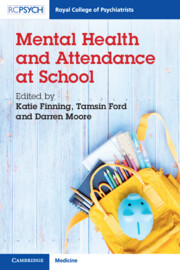Book contents
- Mental Health and Attendance at School
- Mental Health and Attendance at School
- Copyright page
- Contents
- Contributors
- Preface
- Acknowledgements
- Chapter 1 Mental Health and Attendance at School
- Chapter 2 School Attendance
- Chapter 3 Emotional Disorders and Attendance at School
- Chapter 4 Behavioural Disorders and Coping with School
- Chapter 5 Neurodevelopmental Disorders and Attendance at School
- Chapter 6 Educating a ‘New Me’ after an Acquired Brain Injury
- Chapter 7 School Influences on Attendance and Special Educational Needs
- Chapter 8 Supporting the Attendance of Vulnerable Children at School
- Chapter 9 School Attendance and Anxiety
- Chapter 10 Reflections on the Impact of Covid-19 on Children’s Education and Mental Health
- Index
- References
Chapter 1 - Mental Health and Attendance at School
Setting the Scene
Published online by Cambridge University Press: 24 March 2022
- Mental Health and Attendance at School
- Mental Health and Attendance at School
- Copyright page
- Contents
- Contributors
- Preface
- Acknowledgements
- Chapter 1 Mental Health and Attendance at School
- Chapter 2 School Attendance
- Chapter 3 Emotional Disorders and Attendance at School
- Chapter 4 Behavioural Disorders and Coping with School
- Chapter 5 Neurodevelopmental Disorders and Attendance at School
- Chapter 6 Educating a ‘New Me’ after an Acquired Brain Injury
- Chapter 7 School Influences on Attendance and Special Educational Needs
- Chapter 8 Supporting the Attendance of Vulnerable Children at School
- Chapter 9 School Attendance and Anxiety
- Chapter 10 Reflections on the Impact of Covid-19 on Children’s Education and Mental Health
- Index
- References
Summary
Attendance at school can contribute substantially to young people’s optimal development and long-term outcomes. School absenteeism and mental health problems, which are often intertwined, present a major obstacle to optimal development. This chapter introduces research on the relationship between school absenteeism and young people’s mental health problems, including internalising and externalising problems. Attention is also given to the relationship between school attendance and mental health. The authors then present three lenses through which the reader may assimilate the wealth of data and ideas in this book: the multiple needs of young people displaying absenteeism and mental health problems; a multiple disciplinary approach to responding to these needs; and a multi-tiered system of supports for conceptualising, providing, and researching interventions to prevent and address school absenteeism and mental health problems.
Keywords
- Type
- Chapter
- Information
- Mental Health and Attendance at School , pp. 1 - 21Publisher: Cambridge University PressPrint publication year: 2022
References
- 3
- Cited by



